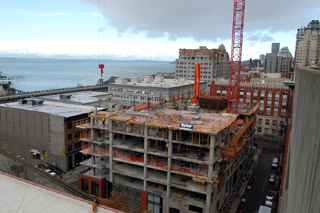|
Subscribe / Renew |
|
|
Contact Us |
|
| ► Subscribe to our Free Weekly Newsletter | |
| home | Welcome, sign in or click here to subscribe. | login |
Construction
| |
 |
March 29, 2012
Washington rolls out new crane regulations
Safety Matters LLC

Richards
|
The state Department of Labor & Industries has adopted new rules for inspection, maintenance and operation of cranes used in the construction industry. At the same time, L&I updated rigging and personnel-lifting requirements.
These rules were developed and adopted with the assistance of a group of industry representatives. They meet the requirement that Washington’s safety rules be at least as effective as the federal rule, which was adopted by the Occupational Safety and Health Administration.
So, let’s begin by identifying Labor & Industries’ definition of a crane.
“Crane” means power-operated equipment used in construction that can hoist, lower and horizontally move a suspended load.
The devices include, but are not limited to: articulating boom cranes, such as knuckle-boom cranes; crawler cranes; floating cranes; cranes on barges; locomotive cranes; mobile cranes, such as wheel-mounted, rough-terrain, all-terrain, commercial truck mounted and boom truck cranes; multipurpose machines configured to hoist and lower by means of a winch or hook and horizontally move a suspended load; industrial cranes, such as carry-deck cranes; dedicated pile drivers; service/mechanic trucks with a hoisting device; cranes on monorails; tower cranes, such as fixed-jib, hammerhead boom, luffing boom and self-erecting; pedestal cranes; portal cranes; overhead and gantry cranes; straddle cranes; side-boom tractors; and derricks.
What is different between state and federal crane regulations? The major differences between the state Division of Occupational Safety and Health’s Cranes, Rigging and Personnel Lifting Regulations and OSHA’s Sub Part CC, The Construction Crane Rule, are:
• Washington’s crane operators can only be certified by using a crane testing organization that is accredited by a nationally recognized accrediting agency. OSHA lists three other methods.
• OSHA has a four-year phase-in for operator certification; DOSH’s is already required.
• All constructions cranes must be inspected and proof load tested by an accredited crane certifier and certified by the state. OSHA does not require this.
• OSHA exempts articulating boom cranes that are delivering material at a construction site; DOSH does not.
• DOSH requires employers to have a preventative maintenance program for their cranes; OSHA does not.
• DOSH requires the assembly/disassembly director to visually inspect and document that the crane components meet the manufacturer’s recommendations, are physically sound, and are assembled/dissembled per the manufacturer’s instructions. This documentation must remain on the jobsite while the crane is in use.
• DOSH defines and requires crane operators, crane owners, crane users, lift directors and site supervisors. It also lists responsibilities of each. OSHA does not mention this.
• DOSH has a whole section devoted to self-erecting tower cranes, while OSHA only briefly mentions them. Currently, there is no national consensus standard for this type of crane.
• OSHA requires a qualified person perform rigging duties. Washington requires written and practical exams for riggers and re-qualification every five years.
• Qualifications for signal persons are identical, except DOSH requires re-qualification every five years.
• Rigging requirements have been completely rewritten to come in line with current industry practices. Washington has several ASME requirements that address slings, rigging hardware and below-the-hook lifting devices. OSHA did not address these requirements.
The new Cranes, Rigging and Personnel Lifting rule became effective Feb. 1. However, the documentation requirement for qualified riggers does not become effective until July 31.
The Cranes, Rigging and Personnel Lifting rule applies to all businesses that own or use cranes and derricks for construction. In addition, all businesses using rigging gear for construction are required to follow applicable sections of the rule.
A full comparison document of OSHA’s and DOSH’s crane rules can be obtained from Cindy Ireland at (360) 902-5522 or Mooc235@lni.wa.gov. This document will also be published on Labor & Industries website: www.lni.wa.gov.
Jennifer Richards is principal of Safety Matters LLC. She has worked in the construction industry since 1987, beginning as a carpenter’s apprentice.
Other Stories:
- Nurturing tomorrow’s construction leaders
- 2012 Construction Surveys: JE Dunn Construction
- 2012 Construction Surveys: Rushforth Construction
- 2012 Construction Surveys: Walsh Construction
- 2012 Construction Surveys: Pease Construction
- 2012 Construction Surveys: W.G. Clark Construction Co.
- Follow these 4 'safety truths' to reduce injuries
- BIM evolves into a safety tool
- Claims clauses: Mike Johnson case is here to stay
- Is your software holding you back?
- One contractor’s trash is another’s office
- Contractors sidestep the bonding blockade
- Succession planning begins at the top
- 2012 Construction & Equipment Surveys



